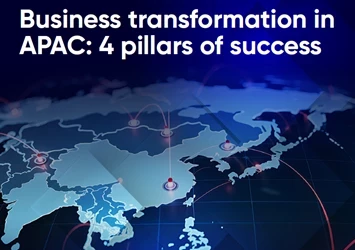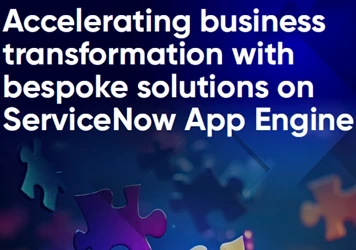Five things we learned from PEX Report 2022
Lessons on process harmonization and intelligent automation from The PEX Report 2022: Global state of process excellence
Add bookmark
In September 2021, we at PEX Network launched our annual state-of-the-industry report, which collated insights from a range of process excellence leaders to share current trends and success stories in the process excellence space. Here we share five important lessons from The PEX Report 2022: Global state of process excellence.
How Spotify implemented 120 bots in less than 18 months
 In January 2020 Spotify launched its intelligent automation (IA) center of excellence (CoE). According to Sidney Madison Prescott, global head of intelligent automation at Spotify, the goal of this CoE was to overhaul the organizational approach to process optimization, allowing automation-at-scale through technologies such as robotic process automation (RPA), artificial intelligence (AI) and machine learning (ML).
In January 2020 Spotify launched its intelligent automation (IA) center of excellence (CoE). According to Sidney Madison Prescott, global head of intelligent automation at Spotify, the goal of this CoE was to overhaul the organizational approach to process optimization, allowing automation-at-scale through technologies such as robotic process automation (RPA), artificial intelligence (AI) and machine learning (ML).
The baseline for this initiative was RPA, which was applied to tasks such as opening emails and attachments, logging into web or enterprise applications, and filing in forms. One of the major successes of this approach came within the team responsible for calculating profit and losses at the end of each quarter, which was utilizing software that was scheduled to be dropped by the end of 2020. The goal of the CoE was to automate this process and keep it running smoothly following the transition away from the traditional software used.
Prior to the automation of this process, employees would spend up to 1,000 minutes manually downloading reports to complete the process. Now that a bot has been implemented to automatically compute transfer pricing, the overall processing time has been reduced by 85 percent and the process now takes only 120 minutes of automated end-to-end bot runtime.
Become a PEX Network member and gain exclusive access to our upcoming digital events, industry reports and expert webinars
Siemens Gamesa’s approach to process harmonization and digital transformation
Since the merger of Gamesa and Siemens Wind Power to form Siemens Gamesa in 2017, the renewable energy industry has experienced significant growth. With this growth has come an increased level of competition, prompting Siemens Gamesa to take steps to innovateits approach to process transformation.
Mark Ghibril, head of regional CIOs and user engagement experience center at Siemens Gamesa, notes that following the merger both businesses had brought with them outdated systems that would require new investment to update. The organization set out on its digital transformation journey, adopting a greenfield approach with the intent to digitalize from the inside-out, ensuring all global operations were aligned. Ensuring conformity across such a vast change management program was a significant challenge, necessitating the implementation of a dedicated team and competence center, putting all employees at the center of the IT changes that were made.
“This enhanced adoption and acceptance of new tools and helped our transformation projects and programs by bringing users and employees along on our very complex journey,” Ghibril explains. “Through physical and virtual town halls and road shows, we presented the argument that change is positive, introduced the new tools it would bring and explained the benefits for the business.”
How Nike is ensuring quality across its supply chain
 Chris Hill, former process excellence manager at Nike, offered insight into an initiative deployed by the global sports apparel company to develop a global shipping performance tool for its North American supply chain. The tool was a virtual basic for applications data solution and was designed to eliminate the need for manual tracking, aggregating and reporting of shipment data through a standardized form, which applied code to automate these processes. The tool was applied to audit and track data from packed shipments, aggregating it into a dashboard that can be refreshed in real-time to provide holistic insight into shipping performance across the organization.
Chris Hill, former process excellence manager at Nike, offered insight into an initiative deployed by the global sports apparel company to develop a global shipping performance tool for its North American supply chain. The tool was a virtual basic for applications data solution and was designed to eliminate the need for manual tracking, aggregating and reporting of shipment data through a standardized form, which applied code to automate these processes. The tool was applied to audit and track data from packed shipments, aggregating it into a dashboard that can be refreshed in real-time to provide holistic insight into shipping performance across the organization.
“By standardizing the process, automating the data feeds and reporting flows, we were able to gather a more real-time and representative view of shipment performance to course-correct where necessary and as quickly as possible,” explains Hill.
With the organization consequently able to track and manage data at a much larger scale, this enabled unprecedented visibility over what changes were necessary to drive successful process excellence initiatives within the supply chain.
How Deutsche Telekom is optimizing P2P with AI and machine learning
Deutsche Telekom Service Europe faced an issue with non-purchase order (PO) related invoices, whereby they were taking a significant amount of time to manually process due to a lack of tax or general ledger account information. To overcome this, the business deployed a team to develop an inhouse AI, dubbed SmartFI. The AI employed optimal character recognition to enable pattern recognition in organizational data for non-PO invoices and boasted a 99.2 per cent accuracy when predicting tax codes and general ledger account information.
Invoice predictions that reached a certain level of confidence were automatically booked while most probable valued were predicted for those that did not. Employees that would traditionally oversee the processing of non-PO invoices were freed up to work on more value-adding tasks, such as overseeing the automated process and working to train the ML algorithms, continuously improving them.
Peter Tasev, SVP P2P and head of finance digitalization at Deutsche Telekom, remarks that: “The biggest result is the optimized capacity for improving the end-to-end P2P process. We are transforming the accounting organization to focus on continuous Improvement rather than reducing backlog.”
How Front Signs drove success when on the brink of collapse
The advent of the Covid-19 pandemic caused significant disruption across many industries, with some businesses being hit harder than others. Front Signs, a sign manufacturing and printing start-up, was one of those that felt the sting of the pandemic, with executives considering halting production or laying off employees as it seemed impossible to continue operating as normal from a financial standpoint.
Not favoring either of these options, the business made the decision to pivot to the production of sneeze guards, face shields, masks and safety signs, which were in high demand as a result of the pandemic. The switch did not require any major process changes, the business simply implemented a new marketing campaign to aid in sale of the new products. With the business able to continue turning profit during the pandemic, a decision was made to implement a ‘you buy, you donate’ campaign, to help fight against the spread of Covid-19 through donations to hospitals with a personal protective equipment shortage. As the business already had a marketing plan in place prior to the pandemic, necessitating flexibility from every department to make the switch happen.
Narine Daveyan, online marketing strategist at Front Signs, notes that: “Our main achievement was that we were able to use our resources and remain self-sufficient, keeping the business going and our staff fully employed, with sales covering production costs.”
To hear these stories in full detail, and find out more about the global state of process excellence, download the report here.






















